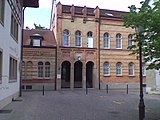Bath and laundry facility in Winterthur
The Winterthur bathing and washing facility (also Badgasse bathing facility or - as an allusion to the striking architectural style - bathtub mosque ) was the first indoor swimming pool in Switzerland. It existed from 1864 to 1915 in the old town of Winterthur on the corner of Badgasse and Neustadtgasse . The building is under regional monument protection and is managed by the federal government as a B object.
Emergence
In the middle of the 19th century medicine recognized the connection between public health and hygiene and demanded - especially in industrial cities with high levels of immigration and social problems - the creation of sufficient hygiene options for the entire population. Bathtubs or even entire bathrooms in private houses were still a privilege of the better-off layers.
The first public bathing establishments in Europe were opened in Liverpool in 1842 , in London in 1845 and in Hamburg in 1854 . In 1864, Winterthur, the first Swiss town, followed suit and opened a splendid bathhouse in a Moorish style . The construction planned by city architect Karl Wilhelm Bareiss was started in 1862 and completed in 1864 and was built right next to the former Lörlibad , which was closed 23 years earlier.
After its construction, the bathtub mosque was to remain the only indoor swimming pool in Switzerland for 44 years until the St. Gallen public baths opened in 1906.
Furnishing
The facility comprised twelve marble baths , two showers , a Turkish bath with a cooling room and a swimming pool . At 12 × 8 m - with a depth between 80 cm and 1.8 m - this was very small even for the conditions at the time and should therefore remain unique in its kind. The interior fittings with horseshoe windows and ornaments were also reminiscent of the bathing culture of the Orient . The chimney was shaped like a minaret .
The bath was only open during the summer months from May to October. As was customary at the time, the baths were strictly segregated according to sex .
Closure
In 1911, the Geiselweid indoor and outdoor pool was opened in Winterthur, Switzerland's first artificial and still existing outdoor pool. The bathhouse was thus obsolete and was closed in 1915. The building then served as a gantry and was to be demolished in 1975, but this was not done after public protests . Today it houses a police station .
Photos: the “Bathtub Mosque” today
See also
literature
- Rolf Wirth: The Volksbad in St. Gallen. From a pioneering act to a cultural asset . VGS, St. Gallen 2006, ISBN 3-7291-1113-2 .
Web links
- Badanstalt Badgasse im Winterthur Glossary.
supporting documents
- ↑ Karl Keller, Winterthurer Stadtbaumeister, in: Winterthurer Jahrbuch 1981, page 147
- ↑ B objects ZH 2018 . Canton of Zurich KGS inventory, B objects, status: 1.1.2018 (the changes for 2018 are marked in blue). In: babs.admin.ch / kulturgueterschutz.ch. Federal Office for Civil Protection FOCP - Department of Cultural Property Protection, January 1, 2018, accessed on December 31, 2017 (PDF; 473 kB, 17 pages, updated annually, the changes for 2018 are marked in blue).
Coordinates: 47 ° 29 '56.3 " N , 8 ° 43' 56.6" E ; CH1903: six hundred ninety-seven thousand four hundred and eighty / 261 717





